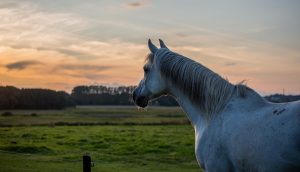Background
Arthritis in horses is mainly detected in the legs and neck. The diagnosis of synovitis of C6-C7 is increasingly being made. In fact, synovitis is a form of osteoarthritis of the facet joints between the 6th and 7th cervical vertebrae. Synovitis means that the inner lining of the joint has become irritated and produces more synovial fluid than normal. The facet joint then becomes overloaded, just as, for example, an ossicular joint can become overloaded in case of overloading or trauma. All joints can be affected by osteoarthritis, including the joints in the neck. This form of osteoarthritis is also called cervical osteoarthritis or cervical spondylosis. This condition is caused by wear of the cartilage of the intervertebral discs. In horses it concerns especially the sixth (C6) and seventh (C7) cervical vertebrae. The cervical vertebrae form the upper part of the spinal column. There is an intervertebral disc between two separate vertebrae. This consists of a ring of fleshy cartilage with a jelly-like core in the middle. These elastic intervertebral discs function as a kind of shock absorber that absorbs the impact of movements. Cervical vertebrae are very flexible. They make it possible for the head to bend forward, backward or sideways. The numerous muscles and bands around the neck vertebrae keep the neck stable during these movements.
Causes
Experience shows that more and more horses are diagnosed with synovitis of C6-C7. The reason is that we are more adequately able to diagnose. Moreover, the current most used training methods cause a lot of pressure on the lower neck vertebrae. As a result, this area is overloaded, which has now been extensively scientifically proven. Without exception, in horses with a synovitis of C6-C7, clinically a lot of pain complaints in the muscles of the neck and limitations in mobility are found low in the neck. As shown on thermographic images, there are strong reactions in this area, which are not limited to the facet joints of the vertebrae. When synovitis of C6-C7 is established, there is much more to it than just a reaction of that particular joint. As mentioned before, the cause is chronic overload due to deep low and round riding. Especially in combination with high rein pressure with or without auxiliary reins. In addition, the use of the so-called rollkur in the training of dressage horses also enhances the development of C6-C7 osteoarthritis.
Diagnosis
The diagnosis of cervical osteoarthritis can be made by a veterinarian by means of X-rays. Sometimes a CT scan, bone scan or MRI scan is required to determine the severity of wear.
Therapy
The treatment that is usually recommended consists of injecting the facet joints with anti-inflammatory medication such as corticosteroids, which also has an analgesic effect. However, it is now also known that it induces damage to the cartilage later in life and is no longer the treatment of first choice. However, due to the low cost and short-term effect, it is still being used extensively. In some cases, the treatment is supplemented with physiotherapy, chiropraxy and/or osteopathy. Sometimes training advice is also given. Only when the cause is known the most important part of the treatment can be initiated. Giving the neck sufficient rest is one of the most important advices in cervical osteoarthritis. In addition, oral anti-inflammatory drugs can be prescribed by the veterinarian to control the pain.
Training advice
The removal of the cause therefore means to adjust the training, which includes: taking the time to learn a horse to wear its weight on the hind leg with sufficient length in the neck (nose on or in front of the perpendicular line). It is not about low acceptance of the bridle but about length in the neck. This creates space between the vertebrae and less pressure in the neck in order for the tissue to be able to recover. By far, most horses can then function perfectly. Length in the neck is not the same as walking without connection between front and rear. The opposite is true. Without a length in the neck a horse does not carry itself and does not close in its lower line. A horse that has a low, deep and round acceptance of the bridle is short in the neck with the hind leg behind the body mass. A horse that has length in the neck (and not necessarily holding it low) must wear itself on the hind leg. A horse that carries itself is walking upright, is light in the hand. Moreover, an increase in pressure on the neck vertebrae will not occur.
Neutraceuticals
Furthermore, a natural alternative can be chosen, such as a liquid combination of Green-lipped mussel, Curcumin and Blackcurrant leaf. These natural anti-inflammatory drugs work just as effectively as regular medicines but do not cause any unpleasant side effects such as on the gastrointestinal tract, for example.






